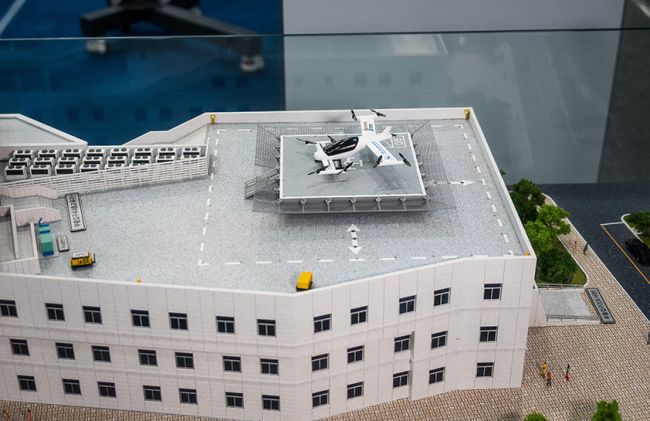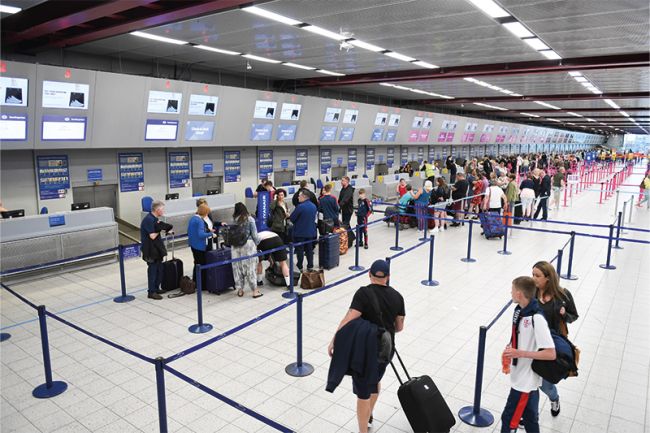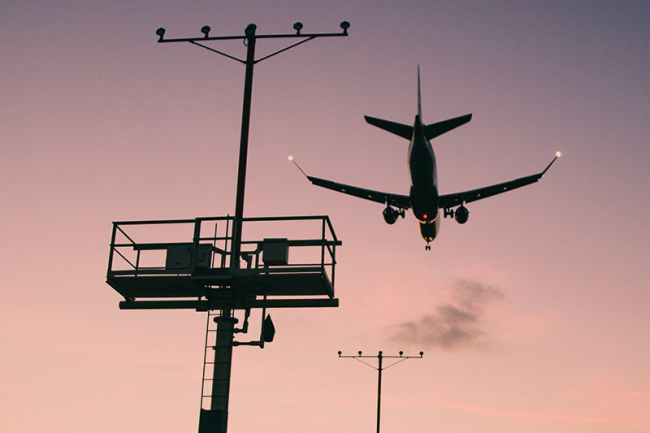Greenville-Spartanburg Airport District's CEO discusses growth, expansion and diversifying revenue as aviation bounces back
Steve Van Beek and Dave Edwards, the President and CEO of the Greenville-Spartanburg Airport District discuss Dave’s distinguished career.

 The aviation industry is hugely important to the social and economic welfare of millions of people across the planet. Heavily consumed within airport management, and with strong credentials in business development, infrastructure, operations, and governmental affairs, we speak to nationally recognized airport executive, David Edwards; President and CEO of the Greenville-Spartanburg (GSP) Airport District. Edwards carries more than 30 years’ experience in airport management and was previously a Chairman of Airport Council International (ACI) North America before taking his role at the District in 2009. He shares his vision and growth opportunities for the District, the impacts of COVID-19 on aviation, and presents a reflection of his airport experience and leadership.
The aviation industry is hugely important to the social and economic welfare of millions of people across the planet. Heavily consumed within airport management, and with strong credentials in business development, infrastructure, operations, and governmental affairs, we speak to nationally recognized airport executive, David Edwards; President and CEO of the Greenville-Spartanburg (GSP) Airport District. Edwards carries more than 30 years’ experience in airport management and was previously a Chairman of Airport Council International (ACI) North America before taking his role at the District in 2009. He shares his vision and growth opportunities for the District, the impacts of COVID-19 on aviation, and presents a reflection of his airport experience and leadership.
Edwards began his career at Miami International before moving to Orlando International Airport where he spent almost 13 years. His first opportunity to lead an organization came through a much smaller authority - Titusville Cocoa Airport Authority. He jumped from an airport with a $1.2 billion capital program in Orlando to a zero-capital program at Titusville Cocoa Airport Authority, but the experience and opportunity led him to Asheville and then his current assignment. “The upstate of South Carolina between Greenville and Spartanburg had an excellent business base with good economic based manufacturing, regional headquarters, and US headquarters facilities for major corporations including Michelin and BMW. It was a very exciting environment to potentially be part of and the experience I gained on both sides, being at two large hub airports for a total of 15 years and then some smaller airports, gave me an opportunity to learn a lot over the years”.
What makes the District enticing and attractive to Edwards is that it’s run more like a private sector business as opposed to a political subdivision or Governmental agency. “My board only meets six times a year and they allow staff to run the airport. There is a lot of leeway and freedom in exchange for building that confidence with the board”. Edwards demonstrates how well the authority is structured, executed, and supported, making it a great operating environment.
With an emphasis on generating and diversifying revenue, and setting the airport up with low debt levels, Edwards successfully implemented a $127 million terminal modernization project from 2012 to 2017 and built the project effectively without borrowing money, delivering a debt free project. “While we understand that some projects will require borrowing, such as the $90m parking garage and rental car facility, we will always put ourselves in a position to diversify revenue streams as best we can to increase cash flow as much as possible”, Edwards explains.
Aviation analysts may be forgiven if they believe that the airport’s margin and revenue generation necessarily require high costs per enplanement or airline charges, but Edwards refutes that and explains exactly how it’s achievable. Back in 2009 cost per enplanement ran at $10 and the percentage of airline revenue as a percentage of total revenue, was running between 35 to 40%. Now airline costs per enplanement are down around $6.50 and have been stabilized for many years. “These results are down to us involving ourselves into other businesses such as running our own Fixed Based Operator (FBO) business, as well as managing all of the commercial fuelling, cargo operation and handling and warehousing for GSP’s international cargo activity. Diversifying is what puts us in a strong position to continue generating a significant amount of revenue, especially during the pandemic”.
It was interesting to gain Edwards’ insight into the new type of terminal concessions contracts and how he recently conducted his RFP process to better allocate risk and get concession businesses attracted to deals in this environment. With the 96% airline traffic drop during COVID, concessionaires were looking for relief. “We put together an RFP for a management agreement for our primary food and beverage operation. We shortlisted from six responses and took a risk in implementing an innovative management agreement structure. While we bear the capital- expenditure costs and face risks as we continue to move and grow the program, we gain a lot of upside revenue potential that we didn't necessarily have under a traditional type of concession agreement. Ultimately, we are here to serve the public, albeit in an unconventional private sector company way”.
In 2016, the District’s traditional FBO agreement was coming up for expiration and the District decided to take full control of their FBO services with the vision and purpose of being able to generate a revenue level that provides the highest level of customer service, both for corporate customers and other general aviation users. Edwards’ philosophy was, “we weren’t going to be the cheapest nor the most expensive, but somewhere in the middle to ensure we could maintain and deliver a high level of customer service and loyalty”. The District’s commitment to this philosophy resulted in the doubling of corporate aviation fuel sales in the first 12-18 months through the execution of competitive pricing and providing high levels of customer service that such entities had not been experiencing previously.
The District invested in a 110,000 sq. ft, $12 million new cargo facility that opened in 2019 and are expanding it further by 50,000 sq. ft due to the significant increases in air cargo demand. The District is set on driving forward more growth opportunities and Edwards reinforces how taking over corporate fuelling operations significantly turned the tables. “While we saw passenger traffic dip during COVID, with fuel volumes consequently taking a hit, we also saw air cargo activity spool up from overseas. For example, a 747-400 aircraft requires 25,000 gallons for one flight, so we've had some of our busiest ever fuel volume months during COVID”.
Like many airports and aviation businesses, the District is working hard to recruit, develop and retain its most valuable resource, its workforce. Managing this as the airport recovers from the pandemic has been a challenge, but new strategies have proven successful. Given the demand of cargo operations and changing supply chains, Edwards has faith in the District’s augmented “core, base workforce” who are the pillars behind delivering the growth strategy as international travel begins to gear back up. “We are using external temporary firms that are able to bring in new talent and we hope to take them on as permanent staff going forward. When I arrived in 2009, we had 80 full time equivalent people and we now have 220 positions here at the District, so things are looking very promising”.
Bouncing back from the Pandemic
Last Spring, the District had hoped that the precipitous drop in passenger traffic would be a short-term blip; while that proved elusive, finally, after 18 months Edwards believes a recovery is underway. “We are predominantly a business-driven market as opposed to a popular tourist destination like our friends in Myrtle Beach and Charleston, who have seen as much as a 150% increase in passenger traffic over Summer since 2019”, Edwards observes.
Based on early discussions in Spring 2021, it looked like businesses in the Upstate were going to re-engage around now (September), however the Delta variant has counteracted that prediction and we’re not likely to see real re-engagement or significant growth of business travel until Q1 of 2022. “The growth trend we were starting to see has now flattened out due to the variant, with traffic recovery commencing at 80% in July 2019, to dropping circa 75% this September. We projected very early on in April 2020 that we would not see full recovery levels until 2024, but we’re on track and continuing to grow and expand the cargo side, which is the silver lining for us”. Edwards highlights.
The District is venturing into non-traditional grant funding sources through Economic Development Assistance (EDA) for some projects and conducting other discussions with surrounding South Carolina airports to collaboratively develop and advocate for a state-based airport funding program.
What does the future at the District look like and what legacy will you be leaving behind?
In the words of Edwards, “like with every job I’ve taken, you should leave it better than when you found it – not to say people were doing a bad job, but the ambition should be to take the organization to the next level in an innovative way”.
While it’s difficult to take risks in a political environment, the District takes pride in thinking outside the box and taking calculated risks to allow everyone to be successful. Leadership to Edwards means building the team for succession. It is about making sure that when he decides to step away, there is a seamless transition without any change or upheaval to the organization, whether it be for the airport commission or his staff team. “I like being on the leading edge of bringing new things to the industry and known for people approaching us about how we achieved success - we’re a very sharing airport in a sharing industry, Edwards reflects.
View and download the Greenville-Spartanburg Airport District Strategic Business Plan 2021-2025.
You can watch the full interview below.






















